Introduction
Asset management is undergoing a significant transformation, driven by the integration of artificial intelligence (AI) technologies. From automating routine tasks to enhancing decision-making processes, AI is reshaping how asset managers operate, offering improved efficiency, accuracy, and client satisfaction.
What is AI and Why Does It Matter in Asset Management?
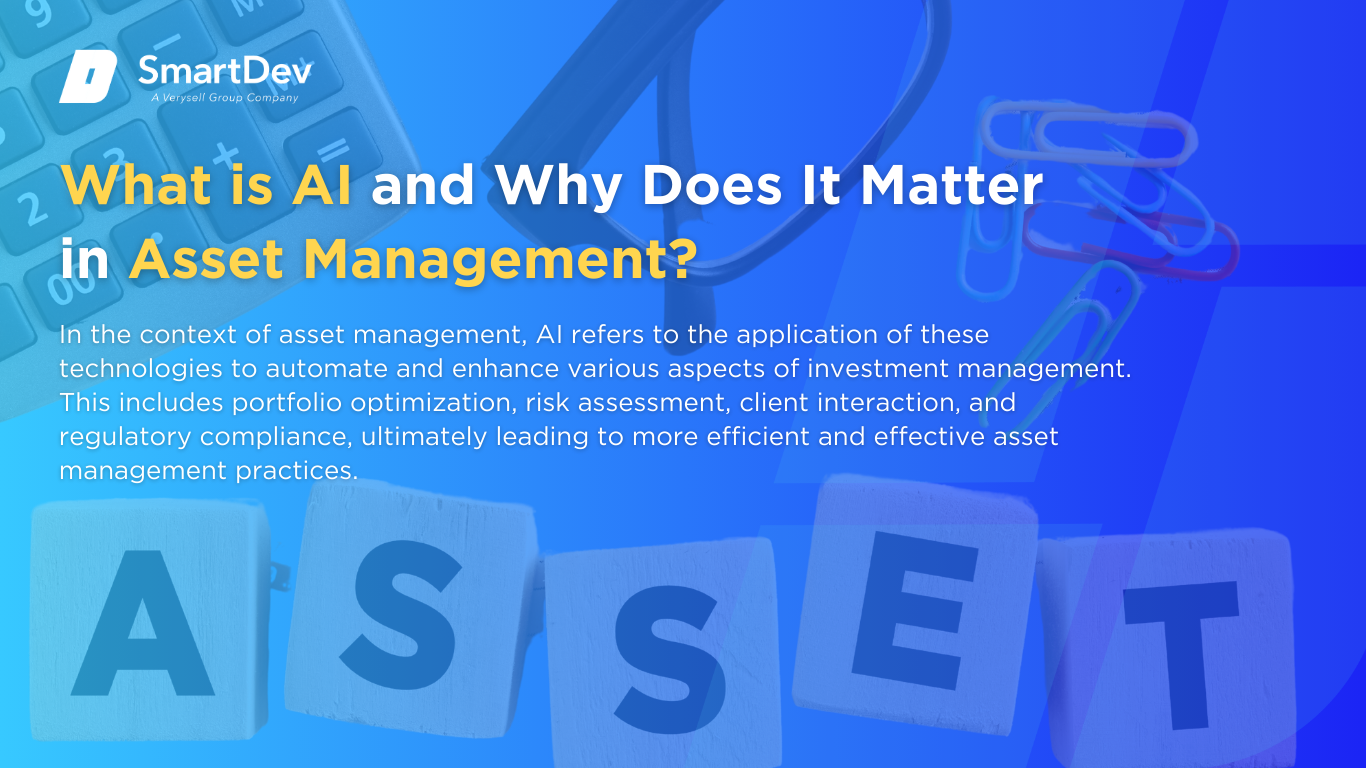
Definition of AI and Its Core Technologies
Artificial Intelligence (AI) encompasses computer systems designed to perform tasks that typically require human intelligence, such as learning, reasoning, and problem-solving. Core technologies within AI include machine learning (ML), natural language processing (NLP), and computer vision. These technologies enable machines to analyze vast datasets, recognize patterns, and make informed decisions.
- Machine Learning (ML): Learns from data to enhance predictions and decisions.
- Natural Language Processing (NLP): Enables machines to interpret human language for maintenance logs or interactions.
- Computer Vision: Processes visual data for quality control and safety monitoring.
- Robotic Process Automation (RPA): Automates repetitive tasks to boost administrative efficiency.
- Edge AI: Processes data on-site for real-time factory decisions.
In the context of asset management, AI refers to the application of these technologies to automate and enhance various aspects of investment management. This includes portfolio optimization, risk assessment, client interaction, and regulatory compliance, ultimately leading to more efficient and effective asset management practices.
Discover how to bring AI into your asset management practice in 2025. Dive into our guide, How to Integrate AI into Asset Management in 2025, and learn how to boost investment performance, streamline portfolio management, and offer smarter, more personalized experiences for your clients—starting today.
The Growing Role of AI in Transforming Asset Management
AI is revolutionizing asset management by enabling more sophisticated data analysis and decision-making. For instance, machine learning algorithms can process vast amounts of financial data to identify investment opportunities and optimize portfolios in real-time. Natural language processing allows for the analysis of unstructured data sources, such as news articles and earnings calls, providing deeper insights into market sentiment and potential risks. This capability enhances the asset manager’s ability to make informed decisions quickly.
Furthermore, AI-driven automation streamlines back-office operations, reducing manual errors and operational costs. Tasks such as compliance monitoring, report generation, and transaction processing can be efficiently managed by AI systems, allowing human resources to focus on strategic activities.
Key Statistics and Trends Highlighting AI Adoption in Asset Management
The adoption of AI in asset management is accelerating. According to a report by the CFA Institute, AI technologies are increasingly being utilized for tasks ranging from portfolio management to client servicing.
A study by EY highlights that generative AI can enable asset managers to proactively manage risks by continuously monitoring market conditions and providing early signals.
Additionally, firms like BlackRock have developed AI platforms such as Aladdin, which provides comprehensive risk analysis and portfolio management solutions, demonstrating the industry’s commitment to integrating AI into their operations.
Business Benefits of AI in Asset Management
AI delivers tangible value in asset management by addressing key challenges such as data overload, risk management, and operational inefficiencies. Below are five distinct benefits:
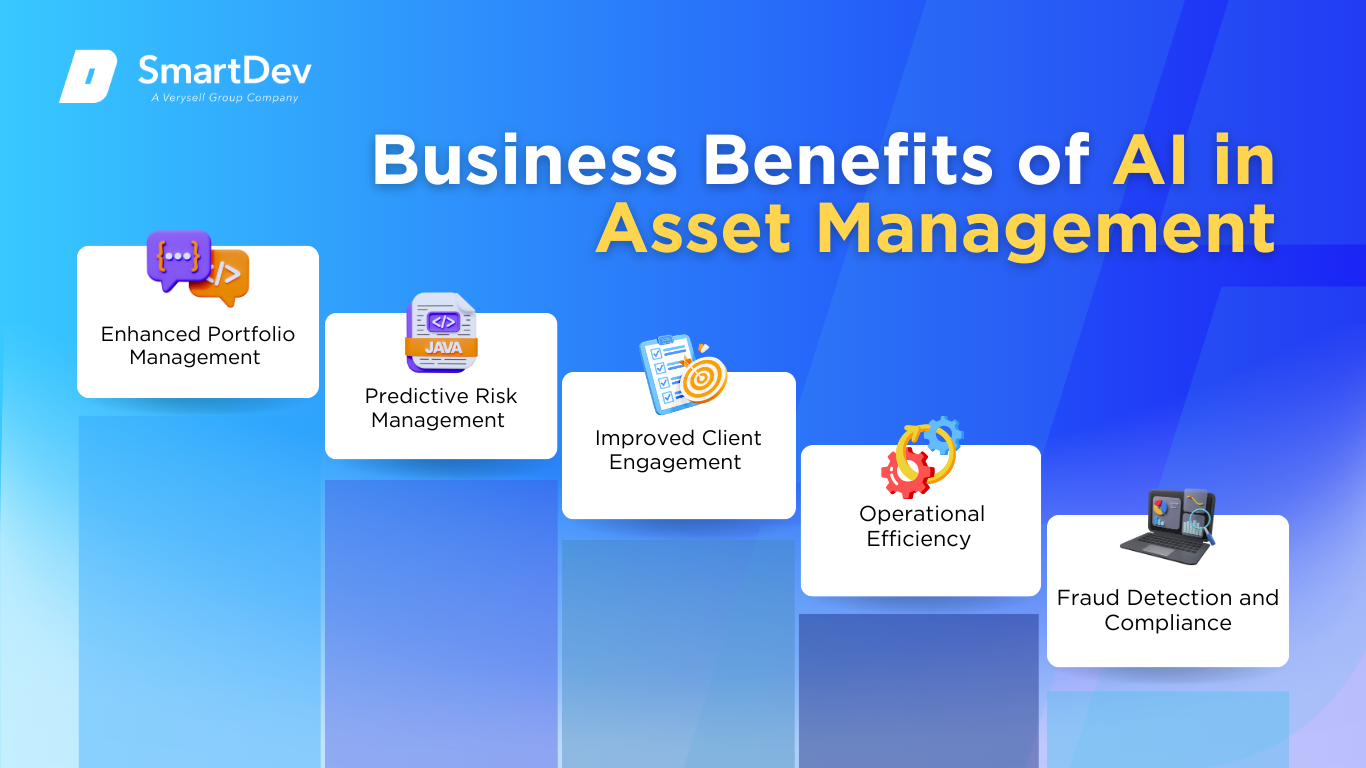
1. Enhanced Portfolio Management
AI algorithms can process vast datasets to identify patterns and forecast market movements, enabling dynamic portfolio rebalancing. This leads to optimized asset allocation and improved investment performance. For example, BlackRock’s Aladdin platform utilizes AI to analyze market data for risk assessment and inform investment strategies.
2. Predictive Risk Management
AI enhances risk management by predicting future risks through the analysis of market trends, geopolitical events, and economic indicators. This proactive approach minimizes potential losses. JP Morgan’s LOXM program exemplifies this by using AI to execute equity trades, optimizing strategies to minimize market impact and improve execution quality.
Explore our latest insights on AI for Risk Management in Fintech: The Way Forward and discover how intelligent technologies can help you stay ahead of risks, improve compliance, and make smarter decisions today.
3. Improved Client Engagement
AI-driven tools personalize client interactions by providing customized investment advice and portfolio recommendations. Chatbots and virtual assistants offer 24/7 support, enhancing customer service. UBS’s SmartWealth platform employs AI algorithms to deliver personalized investment advice based on individual client profiles and risk appetites.
4. Operational Efficiency
AI streamlines back-office operations such as trade processing, compliance monitoring, and report generation, reducing operational costs and improving efficiency. Goldman Sachs utilizes AI to automate complex processes like contract analysis and financial report generation, significantly reducing time and resource expenditure.
5. Fraud Detection and Compliance
AI systems are adept at identifying unusual transaction patterns that may indicate fraudulent activity. By analyzing transaction data in real-time, AI provides an added layer of security against financial fraud. Citigroup has implemented AI-based systems to enhance its fraud detection capabilities, analyzing transaction patterns to identify potential fraudulent activities and providing real-time alerts.
Challenges Facing AI Adoption in Asset Management
Despite the benefits, several challenges hinder the widespread adoption of AI in asset management:
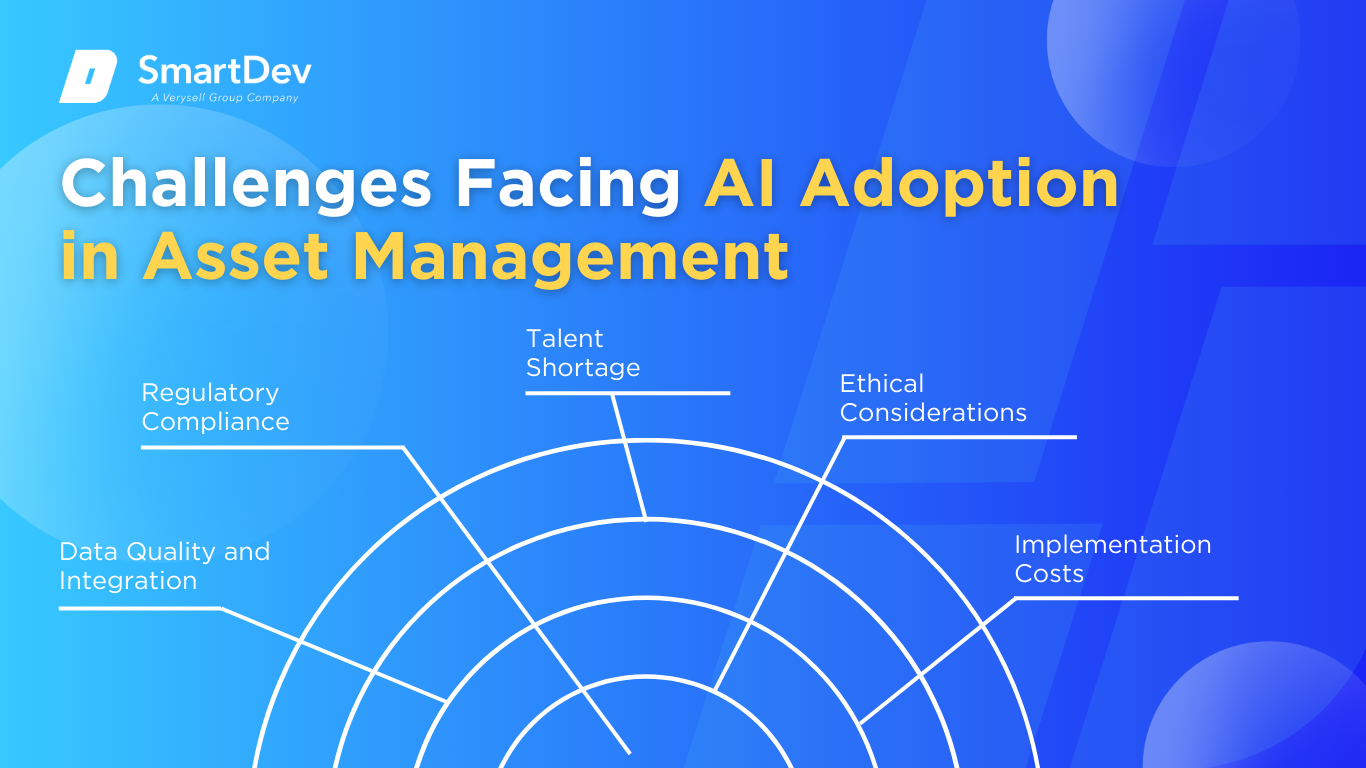
1. Data Quality and Integration
AI systems require high-quality, structured data to function effectively. Many asset management firms struggle with data silos and inconsistent data formats, impeding AI implementation. Integrating disparate data sources into a cohesive system is a complex task that requires significant investment in data management infrastructure.
2. Regulatory Compliance
The use of AI in asset management raises regulatory concerns, particularly regarding transparency and accountability. Regulators require firms to explain AI-driven decisions, which can be challenging given the complexity of some AI models. Ensuring compliance with evolving regulations necessitates ongoing monitoring and potential adjustments to AI systems.
3. Talent Shortage
There is a scarcity of professionals with expertise in both AI and finance. This talent gap makes it difficult for asset management firms to develop and maintain AI systems internally. Firms may need to invest in training programs or partnerships with technology providers to bridge this gap.
4. Ethical Considerations
AI systems can inadvertently perpetuate biases present in training data, leading to unfair or discriminatory outcomes. Addressing these ethical concerns requires careful design and ongoing evaluation of AI models. Implementing ethical AI practices is essential to maintain trust and comply with legal standards.
Beyond many benefits, AI have lots of challenges and the important things is that you need to have a clear and concise understanding about this adoption, from practices, challenges to ethics, you can read more at Master Ethical AI Development: The Definitive Guide | SmartDev
5. Implementation Costs
Developing and integrating AI solutions can be costly, particularly for smaller firms with limited resources. The return on investment may not be immediately apparent, making it challenging to justify the expenditure. Firms must carefully assess the cost-benefit ratio and consider phased implementation strategies to manage expenses.
Specific Applications of AI in Asset Management
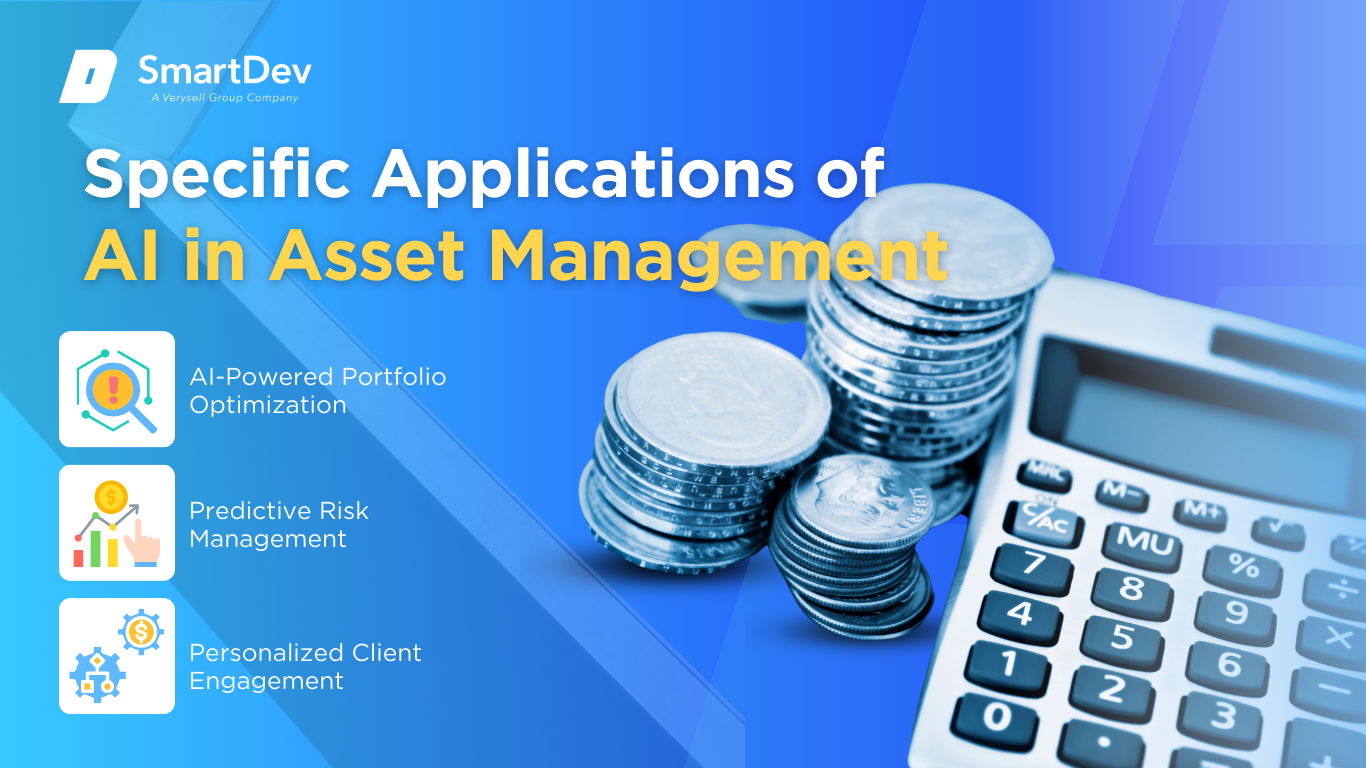
-
AI-Powered Portfolio Optimization
AI-driven portfolio optimization addresses the challenge of balancing risk and return in dynamic markets. Traditional methods often rely on historical data and static models, which may not adapt well to changing conditions. AI algorithms, however, can process real-time data, adjust to market shifts, and optimize asset allocations accordingly.
These systems utilize machine learning techniques to analyze vast amounts of structured and unstructured data, including market trends, economic indicators, and news sentiment. By continuously learning from new information, AI models can forecast asset performance and suggest portfolio adjustments to maximize returns while managing risk.
The strategic value lies in AI’s ability to provide dynamic, data-driven insights that enhance investment decisions. This leads to more resilient portfolios that can adapt to market volatility and changing investor preferences. However, implementing AI requires careful consideration of data quality, model interpretability, and regulatory compliance.
Case Study: BlackRock’s Aladdin platform
For example, BlackRock’s Aladdin platform integrates AI to analyze market data and optimize portfolios. Aladdin processes vast datasets to assess risk and suggest asset allocations, supporting investment decisions across various asset classes. This has enabled BlackRock to manage over $21.6 trillion in assets effectively.
-
Predictive Risk Management
Managing risk is paramount in asset management, and AI enhances this by predicting potential market downturns and identifying emerging risks. Traditional risk models often fall short in anticipating complex, nonlinear market behaviors. AI models, trained on diverse datasets, can uncover hidden risk factors and provide early warnings.
These models employ techniques like natural language processing to analyze news articles, social media, and financial reports, detecting sentiment shifts and potential market-moving events. By integrating these insights, asset managers can proactively adjust strategies to mitigate risks.
The operational value includes improved risk-adjusted returns and enhanced compliance with regulatory requirements. However, challenges such as model transparency and the potential for algorithmic bias must be addressed to ensure ethical and effective risk management.
Case Study: JPMorgan’s AI tools
JPMorgan’s AI tools exemplify this application by analyzing market conditions and client data to anticipate risks. During the April 2025 market turmoil, JPMorgan’s AI systems enabled rapid, personalized client responses, contributing to a 20% increase in asset and wealth management sales.
-
Personalized Client Engagement
AI enhances client engagement by delivering personalized investment advice and services. Traditional approaches often lack the scalability to provide individualized attention to a large client base. AI-driven systems can analyze client data to tailor recommendations and communications.
These systems use machine learning to assess client preferences, risk tolerance, and financial goals, enabling the delivery of customized investment strategies. Natural language processing allows for the creation of personalized content and interactions, improving client satisfaction and retention.
The strategic advantage is the ability to scale personalized services, fostering deeper client relationships and competitive differentiation. However, ensuring data privacy and addressing potential biases in recommendations are critical considerations.
Case study: Rowboat Advisor’s portfolio management software
Betterment’s acquisition of Rowboat Advisors illustrates this use case. By integrating Rowboat’s portfolio management software, Betterment enhanced its platform to offer personalized investing solutions, including direct indexing and tax optimization, attracting more registered investment advisors and expanding its client base.
To explore more the effective of AI uses case in asset management, you can find information about Our projects and solutions we’ve developed in collaboration with our valued clients.
Examples of AI in Asset Management
Real-World Case Studies
Real-world implementations of AI in asset management demonstrate its transformative impact across various functions, from portfolio management to client engagement.
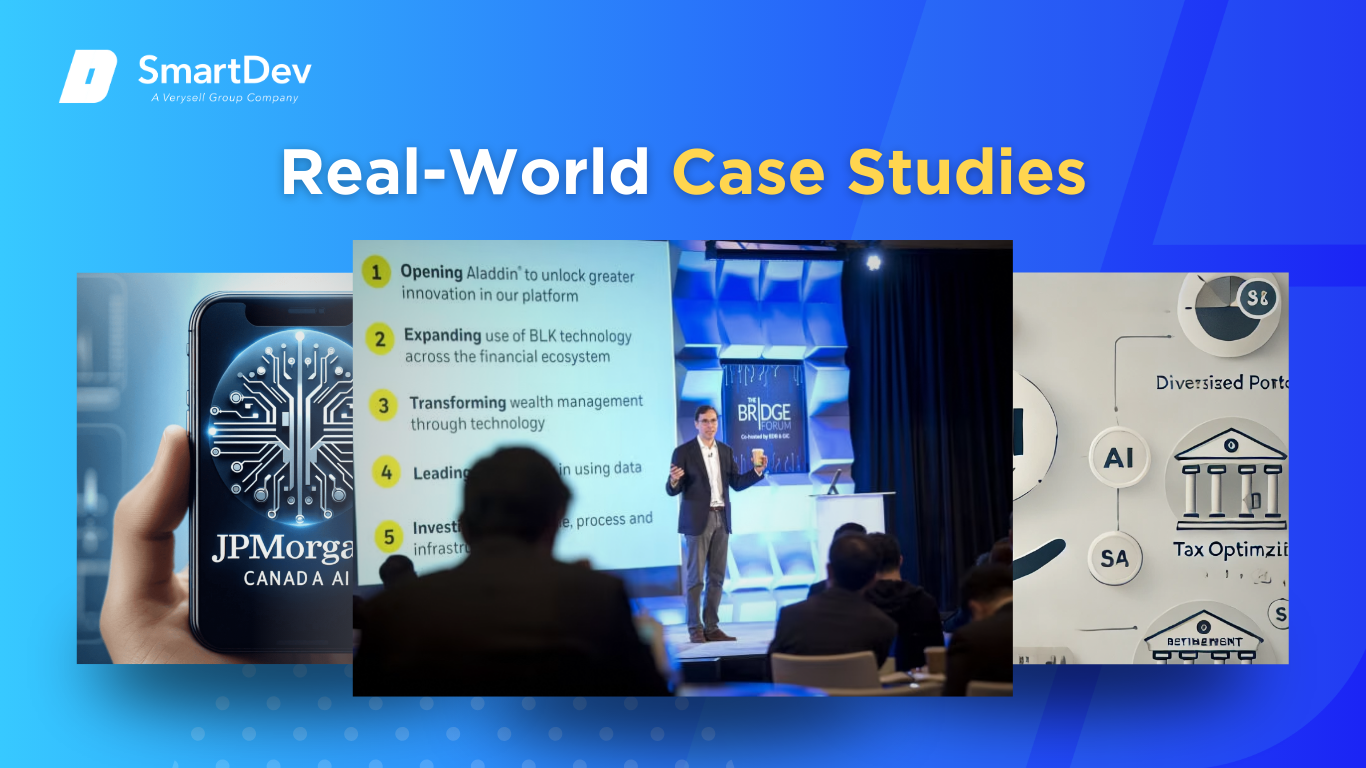
1. BlackRock: Transforming Portfolio Management with Aladdin
BlackRock, managing trillions in assets, faced the complexity of integrating vast datasets across diverse asset classes. Traditional systems struggled with real-time risk assessment and dynamic portfolio adjustments, especially during volatile market conditions.
To address these challenges, BlackRock developed Aladdin, a comprehensive platform combining risk analytics, portfolio management, and trading operations. Aladdin leverages AI to process over 15 billion data points daily, enabling real-time insights and predictive analytics for investment decisions.
The implementation of Aladdin has led to significant improvements in investment management processes. Users report increased efficiency in data analysis and decision-making, allowing for more informed investment strategies. The AI-driven insights have also contributed to better risk management and portfolio optimization, demonstrating the transformative potential of generative AI in the financial sector.
2. JPMorgan Chase: Enhancing Client Engagement with AI
During periods of market volatility, JPMorgan faced the challenge of providing timely and personalized advice to a vast clientele. Traditional methods were insufficient for rapid data retrieval and client communication, leading to potential client dissatisfaction.
JPMorgan introduced Coach AI, an AI-driven platform designed to assist advisors by quickly retrieving relevant research and anticipating client inquiries. This tool integrates with the bank’s systems to provide real-time data analysis and personalized recommendations.
The deployment of Coach AI significantly enhanced advisor productivity, with research retrieval times reduced by 95%. During the April 2025 market turmoil, JPMorgan reported a 20% year-over-year increase in asset and wealth management sales, attributing this growth to the efficiency and responsiveness enabled by AI tools.
3. Betterment: Personalizing Investment Strategies through AI
Betterment aimed to expand its services to independent registered investment advisors (RIAs) but faced limitations in offering personalized investment strategies, such as direct indexing and tax optimization.
To overcome this, Betterment acquired Rowboat Advisors, a provider of portfolio management software specializing in direct indexing and tax optimization. This acquisition allowed Betterment to integrate advanced AI-driven tools into its platform, enhancing its capabilities for personalized investing.
Post-acquisition, Betterment enhanced its platform to offer more complex and customized portfolios, attracting a broader range of RIAs. The integration of Rowboat’s technology enabled Betterment to provide direct indexing capabilities, meeting the growing demand for personalized investment solutions.
Innovative AI Solutions
The asset management industry is undergoing a profound transformation fueled by cutting-edge AI technologies that address long-standing challenges and unlock entirely new capabilities. These advancements not only streamline traditional workflows but also empower asset managers with deeper insights and enhanced decision-making tools, setting the stage for a more agile and client-centric future.
1. Generative AI for Enhanced Investment Research
Generative AI models are revolutionizing how investment research is conducted by automating the extraction and synthesis of insights from vast, complex datasets. These models can swiftly analyze unstructured financial documents, earnings call transcripts, market news, and even social media sentiment to uncover emerging trends and thematic opportunities.
For example, BlackRock has integrated generative AI into its Aladdin platform, enabling portfolio managers to construct thematic investment baskets—such as those focused on cutting-edge pharmaceutical innovations—far more efficiently. This approach reduces the manual burden of data analysis while improving the breadth and depth of research, allowing investment teams to focus on strategic decision-making rather than data gathering.
2. AI-Powered Client Interaction and Personalization Tools
Financial institutions are increasingly leveraging AI-driven chatbots and virtual assistants to transform client engagement and service delivery. These intelligent systems provide instantaneous, 24/7 responses to client inquiries, assist with complex account management tasks, and offer tailored financial advice based on individual client profiles and market conditions.
By personalizing interactions and proactively anticipating client needs, these tools enhance satisfaction and build trust, while simultaneously reducing the operational costs associated with human customer service. The integration of natural language processing and machine learning allows these virtual assistants to continuously improve their accuracy and relevance, fostering deeper, more meaningful client relationships.
3. Advanced Predictive Analytics for Market Forecasting and Risk Management
Predictive analytics powered by AI models are becoming indispensable in forecasting market trends and asset performance with greater accuracy and speed. By analyzing a combination of historical market data, real-time economic indicators, geopolitical events, and alternative data sources, these tools offer forward-looking insights that enable proactive portfolio adjustments.
Asset managers can identify early warning signals for potential risks, capitalize on emerging opportunities, and optimize asset allocation dynamically. This predictive capability not only enhances returns but also strengthens risk management frameworks, providing a robust foundation for strategic investment decisions in volatile and complex markets.
AI-Driven Innovations Transforming Asset Management
-
Emerging Technologies in AI for Asset Management
Artificial intelligence is revolutionizing asset management by enhancing decision-making processes and operational efficiency. Generative AI, for instance, is being utilized to automate the summarization of complex investment documents, such as Confidential Information Memorandums (CIMs).
Rackspace Technology leveraged advanced Generative AI capabilities to streamline and automate the summarization of CIMs, producing concise documents and presentations that capture core details, thereby improving efficiency and reducing manual effort.
Computer vision, another facet of AI, is employed for visual data analysis in asset management. For example, AI-powered visual inspections can detect anomalies or defects in assets through image analysis, enabling proactive maintenance and reducing downtime.
-
AI’s Role in Sustainability Efforts
AI contributes to sustainability in asset management by optimizing energy consumption and reducing waste. Predictive analytics can forecast equipment failures, allowing for timely maintenance and minimizing resource wastage. These models analyze historical data to identify patterns and predict when a component might fail, which significantly reduces the need for emergency repairs and extends the life of assets.
Smart systems powered by AI can adjust energy usage in real-time, enhancing energy efficiency across operations. For example, facility management systems embedded with AI can dynamically regulate lighting, heating, and cooling based on occupancy and usage patterns. This not only cuts down operational costs but also contributes to achieving ESG (Environmental, Social, and Governance) targets. By integrating AI into their sustainability strategy, asset managers can demonstrate a commitment to responsible investing and gain favor with environmentally-conscious stakeholders.
How to Implement AI in Asset Management
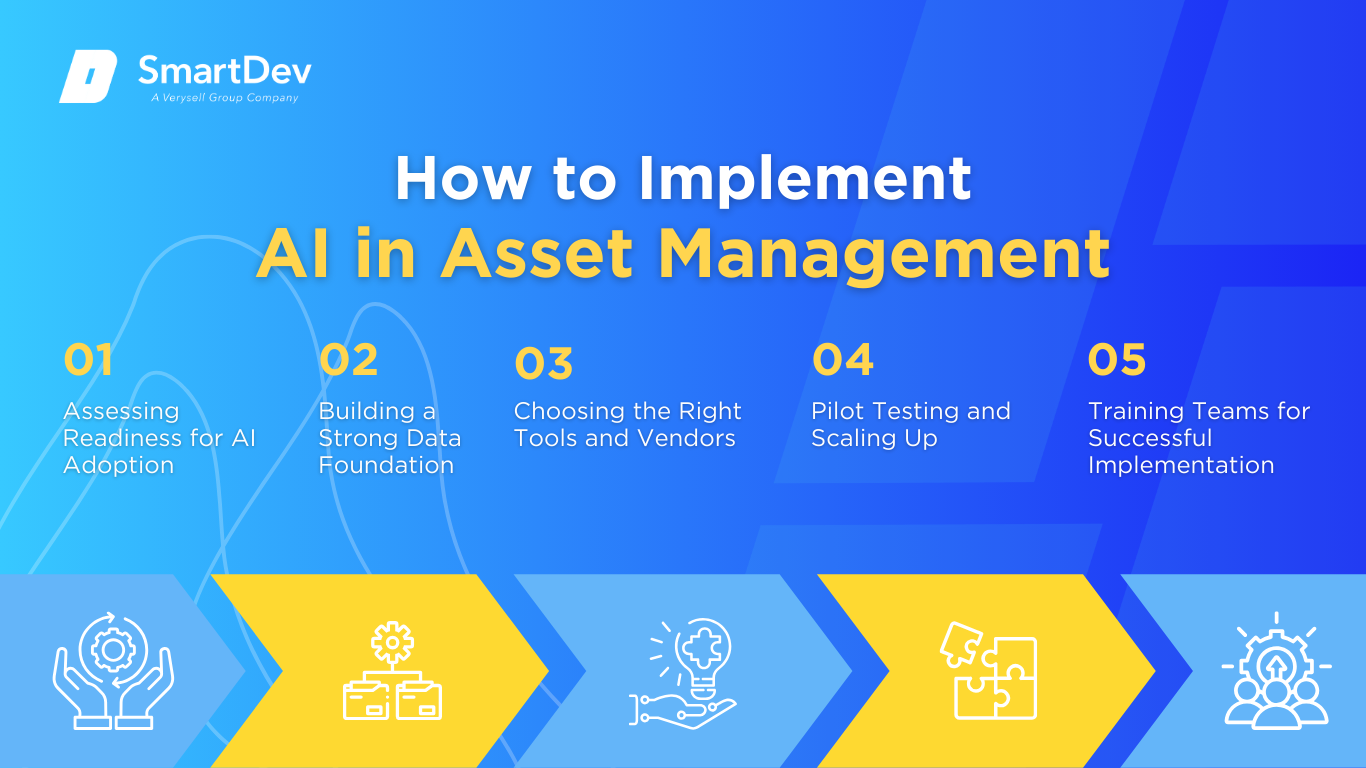
-
Assessing Readiness for AI Adoption
Before integrating AI, organizations must assess their readiness by identifying areas where AI can add value. This involves a thorough evaluation of internal processes, technology infrastructure, and data capabilities. Leaders must ask: Where are the bottlenecks, and can AI feasibly solve them? Are we collecting the right data, and is it accessible?
Understanding the specific needs and challenges of the organization guides the selection of appropriate AI solutions. It’s crucial to involve cross-functional teams in this assessment to ensure a comprehensive understanding of how AI will integrate with existing workflows. Additionally, assessing the culture of the organization—its openness to change and innovation—plays a vital role in AI adoption.
-
Building a Strong Data Foundation
A robust data foundation is critical for successful AI implementation. This includes establishing processes for data collection, cleaning, and management. Data must be structured, relevant, and timely to train AI models effectively. Firms should also consider leveraging external data sources such as market sentiment, macroeconomic indicators, and alternative data like satellite imagery.
Ensuring data quality and accessibility enables AI systems to generate accurate insights and predictions, which are essential for informed decision-making in asset management. Investing in data governance frameworks helps maintain data integrity, privacy, and compliance with regulatory standards. This foundational step cannot be skipped, as even the most advanced AI solutions are only as good as the data they analyze.
-
Choosing the Right Tools and Vendors
Selecting suitable AI tools and vendors requires thorough evaluation of available solutions and their compatibility with organizational needs. Key considerations include the scalability of the solution, ease of integration with existing systems, support from the vendor, and adherence to industry regulations such as GDPR or FINRA.
Collaborating with vendors who have a proven track record in asset management can facilitate smoother implementation. Conducting a detailed due diligence process, including pilot evaluations and vendor references, ensures that the selected partner can deliver long-term value. Look for platforms that offer customization and have the ability to evolve with your firm’s strategic goals.
-
Pilot Testing and Scaling Up
Implementing AI should begin with pilot projects to test the effectiveness of chosen solutions. These pilots offer valuable insights into system performance, usability, and integration challenges. They also provide a low-risk environment to evaluate return on investment and identify areas of improvement.
Once validated, these solutions can be scaled up across the organization. The key to successful scaling lies in continuous feedback, performance monitoring, and process optimization. Leaders should develop a roadmap for gradual implementation that aligns with strategic goals and available resources.
-
Training Teams for Successful Implementation
Employee training is vital for the successful adoption of AI technologies. Providing staff with the necessary skills to work alongside AI systems ensures that they can effectively interpret AI-generated insights and make informed decisions. Upskilling initiatives should include both technical training and soft skills like critical thinking and change management.
Continuous learning opportunities will help teams stay updated with evolving AI capabilities. Moreover, involving employees early in the AI journey can alleviate fears and increase buy-in. Embedding a culture of innovation and learning ensures that AI becomes an enabler rather than a disruptor.
AI is transforming asset management—from advanced portfolio analytics and real-time market insights to personalized client engagement. Connect with our team to discover customized AI solutions that enhance efficiency, drive innovation, and enable smarter, data-driven investment decisions across your asset management processes.
Measuring the ROI of AI in Asset Management
-
Key Metrics to Track Success
Evaluating the return on investment (ROI) of AI in asset management involves tracking specific and measurable performance indicators. One of the most significant metrics is productivity improvement. By automating routine tasks like compliance reporting or client communications, AI can significantly reduce processing times, freeing up human resources for strategic activities.
Another crucial metric is cost savings. Automation of data analysis, risk assessments, and transaction processing can lower operational costs. Furthermore, AI improves decision-making accuracy by offering predictive analytics and real-time insights, leading to more profitable investment strategies. Tracking client retention rates and satisfaction scores can also highlight AI’s role in enhancing client experiences.
Additionally, firms can monitor the time-to-market for new financial products, error rates in reporting, and operational downtime—each offering insight into how AI contributes to operational excellence. Benchmarking these KPIs before and after AI implementation provides a quantifiable view of AI’s value.
-
Case Studies Demonstrating ROI
A notable example is Chesamel’s collaboration with a Japanese asset management firm to develop an AI-based ETF-like investing product. By analyzing decades of economic and market data, the AI system could suggest more resilient portfolio structures. The results were compelling: annual returns increased from 6% to 13%, while portfolio drawdowns improved from 32% to 25%. This not only demonstrated enhanced profitability but also showcased better risk mitigation.
Another success story is BlackRock’s Aladdin platform. Aladdin uses AI and big data analytics for comprehensive risk analysis and portfolio management. The platform processes massive volumes of market data to inform investment decisions and identify hidden risks. Since its inception, Aladdin has significantly contributed to BlackRock’s reputation for precision risk management and is now licensed to hundreds of asset managers globally, underlining the scalability and financial return of AI integration.
Measuring ROI from AI initiatives can be challenging for many businesses and institutions due to varying costs, goals, and levels of readiness. If you’re looking to explore this topic in depth, check out AI Return on Investment (ROI): Unlocking the True Value of Artificial Intelligence for Your Business.
-
Common Pitfalls and How to Avoid Them
Implementing AI in asset management can present challenges, such as poor data quality, lack of skilled personnel, and resistance to change. Many firms underestimate the importance of high-quality, clean data. Garbage in, garbage out still applies in AI, and without proper data practices, results can be misleading or even damaging.
To mitigate these risks, organizations should invest in data governance, provide ongoing training, and foster a culture that embraces technological innovation. Engaging stakeholders throughout the implementation process—especially those on the front lines—can reveal critical operational nuances. Finally, ensure AI adoption aligns with broader strategic goals to prevent disjointed or fragmented implementations.
Future Trends of AI in Asset Management
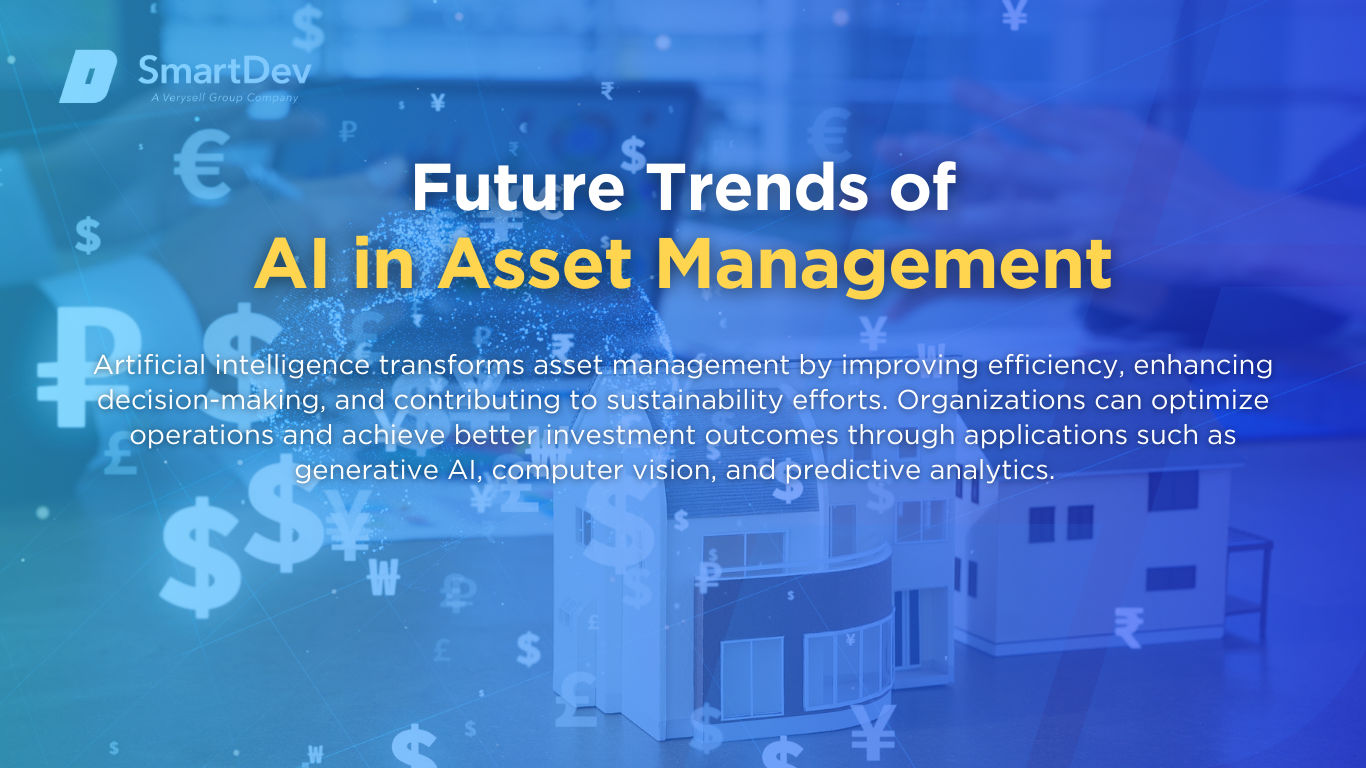
Predictions for the Next Decade
Over the next decade, AI is expected to become increasingly integral to asset management. Continued advancements in machine learning and deep learning will unlock more complex predictive models. These tools will provide asset managers with near real-time investment recommendations, allowing firms to react instantly to market changes.
Furthermore, AI’s integration with blockchain and IoT will create new possibilities in asset tracking, digital ledger maintenance, and real-world data utilization. Personalized investment experiences powered by natural language processing and AI chatbots will become the norm, revolutionizing client engagement and portfolio customization.
How Businesses Can Stay Ahead of the Curve
To remain competitive, asset management firms should continuously monitor technological developments and adapt accordingly. Investing in in-house AI talent, building partnerships with AI startups, and creating sandbox environments for experimentation will foster innovation.
Business leaders must champion AI adoption by aligning it with business strategy and risk management frameworks. Being proactive rather than reactive, and treating AI as a strategic asset, will help firms stay resilient and agile in a rapidly evolving industry.
Conclusion
Key Takeaways
Artificial intelligence transforms asset management by improving efficiency, enhancing decision-making, and contributing to sustainability efforts. Organizations can optimize operations and achieve better investment outcomes through applications such as generative AI, computer vision, and predictive analytics.
Implementing AI requires careful planning—from readiness assessments and data management to tool selection and team training. With the right approach, AI can deliver measurable ROI and long-term value.
Moving Forward: A Path to Progress
If your firm is looking to drive innovation, increase profitability, and gain a competitive edge, now is the time to explore AI in asset management. Start by assessing your organization’s readiness, strengthening your data foundation, and identifying areas where AI can deliver the most value. Partner with trusted AI solution providers and invest in upskilling your teams to ensure a successful transformation. The future of asset management is intelligent—don’t get left behind.
Let’s shape that future together.
—







